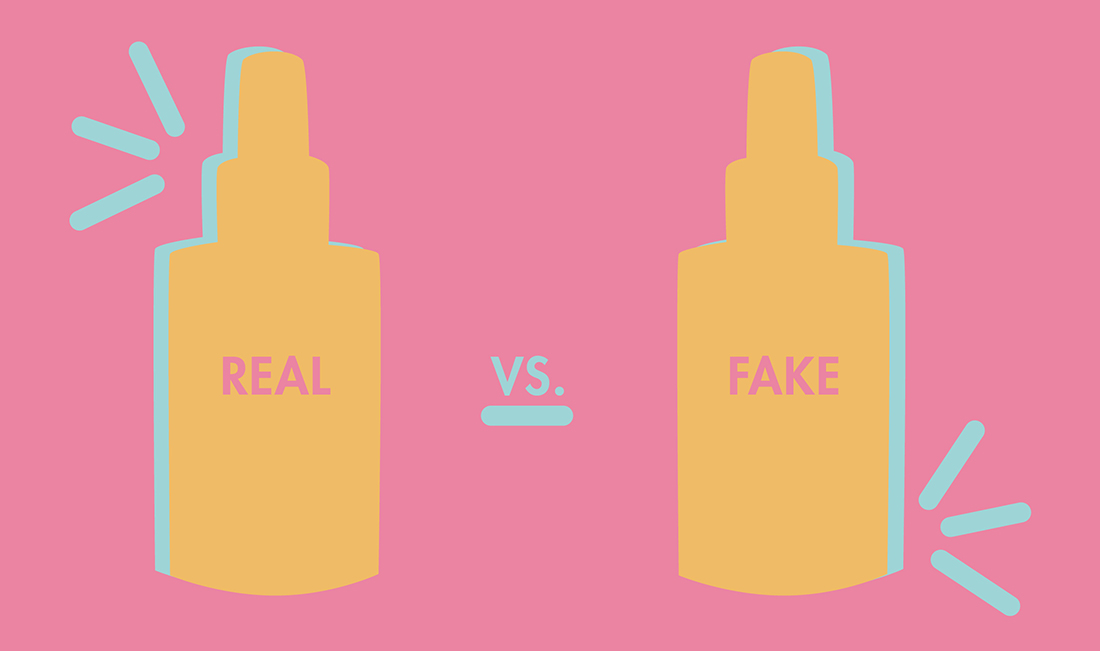Fake luxury goods aren’t the only counterfeit products on the black market. In fact, counterfeit skin care and makeup has erupted into a burgeoning business. Read on to learn how to tell the difference between counterfeit and real skin care products.
Even if you’d never knowingly purchase a counterfeit skin care product, it’s possible to accidentally do so. Knowing what to look for and enlisting responsible shopping strategies can ensure you steer clear of these potentially dangerous products.
We’re surrounded by counterfeit skin care and beauty products. Knowing that is your first step in avoiding fakes, which are not only subpar in quality compared to the real deal but can actually contain dangerous ingredients or create gnarly skin issues. With expert input, we’re breaking down everything you need to know about counterfeit skin care products, including why they’re bad news and how to spot fakes.
Why Are Counterfeit Skin Care Products Even a Thing?
Maybe you saw the counterfeit makeup episode on Netflix’s Broken series, maybe you’ve seen murmurings about fakes, or maybe you’ve seen or even purchased some of these products yourselves. As we mentioned above, these products are plentiful — but why? The short answer: for the same reasons dupes exist across all consumer industries.
“The brand name becomes a hot commodity, noted for its quality in most cases or in other cases, just for its great marketing. There will always be consumers looking to get that same experience at a cheaper price tag, and counterfeit merchants take advantage of pre-existing brand loyalty to make a profit,” explains Young Lin, a cosmetic researcher and the founder of Derm Institute.
The same occurs in skincare. In some cases, counterfeit skin care and beauty purchases are the result of people not really understanding the ramifications of using potentially dangerous products and therefore not caring if the product is genuine. However, there are also instances where dishonest people take advantage of consumers who genuinely don’t know the difference between authentic formulations and counterfeit skin care products.
The bottom line is that the lower price tag and brand name entices people to buy these products — knowingly or unknowingly — but it can come at a higher cost to your overall health.
The Dangers of Counterfeit Skin Care and Beauty Products
You can buy a rip-off designer handbag and not really put your health at risk (though this does impact the authentic producer financially), but it’s a different story when actively applying counterfeit skin care and beauty products.
“Skin care does have regulations to follow, but when you are dealing with a counterfeit brand then they are not likely following those regulations. Their ingredients have not passed quality control testing, they are bypassing clinical testing, bacteria control standards, and could be using toxic ingredients that don’t protect your overall health,” says Lin.
She tells us there have been reports of counterfeit cosmetics containing dangerous levels of bacteria, toxic ingredients such as lead, and known carcinogens such as arsenic, beryllium, and cadmium. In addition to potentially poisoning you, counterfeit skin care products can lead to acne, infections, skin rashes, psoriasis, and other conditions. Consumers should be wary of this.
How to Tell if a Skin Care Product is Counterfeit
There are a few good ways to ensure you’re getting an authentic product versus a counterfeit:
The product was purchased from a trusted, reliable retailer. Products purchased from untrusted websites, unverified dealers on Amazon and Taobao, or on the street are risky. Lin says to buy products directly from the brand’s website — or from one of the brand’s listed authorized retailers — to be sure you’re not getting duped. One example is Soko Glam, which is an authorized retailer for over 60 Korean beauty brands.
The product is priced normally. If the item is priced far below the retail price, then there’s a solid chance it’s not the real deal. The product itself smells or feels off. “If you have the chance to feel the real product in person at an authorized retailer, you’ll usually notice that the texture is not the same in counterfeit products,” notes Lin.
The labeling is authentic. One of the biggest giveaways of a counterfeit skin care product is the packaging and labeling. Spelling errors, weird colors, unusual fonts, and uneven sticker placement are all signs you’ve got a counterfeit skin care product.














